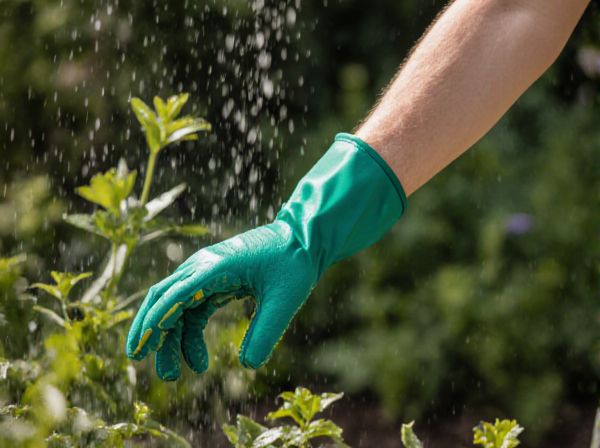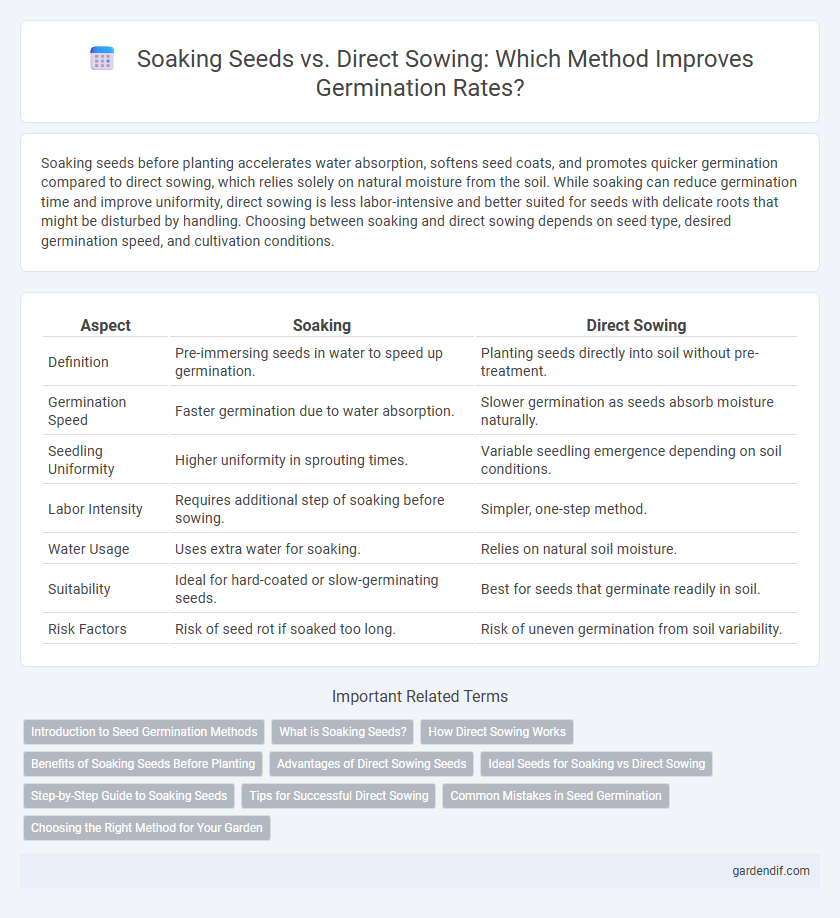
Soaking vs Direct Sowing Illustration
Soaking seeds before planting accelerates water absorption, softens seed coats, and promotes quicker germination compared to direct sowing, which relies solely on natural moisture from the soil. While soaking can reduce germination time and improve uniformity, direct sowing is less labor-intensive and better suited for seeds with delicate roots that might be disturbed by handling. Choosing between soaking and direct sowing depends on seed type, desired germination speed, and cultivation conditions.
Table of Comparison
| Aspect | Soaking | Direct Sowing |
|---|---|---|
| Definition | Pre-immersing seeds in water to speed up germination. | Planting seeds directly into soil without pre-treatment. |
| Germination Speed | Faster germination due to water absorption. | Slower germination as seeds absorb moisture naturally. |
| Seedling Uniformity | Higher uniformity in sprouting times. | Variable seedling emergence depending on soil conditions. |
| Labor Intensity | Requires additional step of soaking before sowing. | Simpler, one-step method. |
| Water Usage | Uses extra water for soaking. | Relies on natural soil moisture. |
| Suitability | Ideal for hard-coated or slow-germinating seeds. | Best for seeds that germinate readily in soil. |
| Risk Factors | Risk of seed rot if soaked too long. | Risk of uneven germination from soil variability. |
Introduction to Seed Germination Methods
Soaking seeds before planting accelerates water absorption, triggering enzymatic processes essential for germination and enhancing seedling vigor. Direct sowing places seeds straight into the soil, allowing natural environmental factors like moisture and temperature to regulate germination timing. Each method impacts germination success rates, with soaking often favored for hard-coated or slow-germinating seeds to improve uniformity and reduce establishment time.
What is Soaking Seeds?
Soaking seeds involves immersing them in water for a specific period to soften the seed coat and accelerate the germination process by facilitating water absorption and enzymatic activation. This technique enhances germination rates and reduces wait time compared to direct sowing, where seeds are planted directly into soil without pre-treatment. Soaking is particularly beneficial for hard-coated seeds that naturally have slower moisture uptake.
How Direct Sowing Works
Direct sowing involves planting seeds directly into the soil without prior soaking, allowing natural soil moisture to initiate germination. Seeds absorb water from the surrounding earth, activating enzymes necessary for cell division and growth, promoting strong root and shoot development. This method reduces transplant shock and is especially effective for crops adapted to local soil and climate conditions.
Benefits of Soaking Seeds Before Planting
Soaking seeds before planting accelerates germination by softening the seed coat and activating metabolic processes, leading to faster and more uniform sprouting. This technique enhances water absorption, improves seedling vigor, and increases the chances of successful establishment in various crops such as beans, peas, and corn. By reducing germination time and improving overall seedling health, soaking seeds can significantly boost early plant growth and productivity.
Advantages of Direct Sowing Seeds
Direct sowing seeds promotes stronger root systems by allowing plants to establish naturally in their environment, enhancing resilience and growth. This method reduces labor and resource input, eliminating the need for transplanting and minimizing transplant shock. Seeds sown directly also experience less disturbance, leading to higher germination rates and more robust seedlings in suitable soil conditions.
Ideal Seeds for Soaking vs Direct Sowing
Seeds with hard or thick coats, such as beans, peas, and certain tree seeds, benefit most from soaking to soften the seed coat and accelerate germination. In contrast, small, delicate seeds like lettuce, carrots, and many herbs are ideal for direct sowing as they require minimal disturbance and immediate soil contact for optimal sprouting. Selecting seeds based on their coat characteristics and germination requirements ensures higher success rates and healthier seedlings.
Step-by-Step Guide to Soaking Seeds
Soaking seeds before planting accelerates germination by softening the seed coat and triggering metabolic activities essential for sprout development. Begin by selecting high-quality seeds, then soak them in lukewarm water for 8 to 12 hours, ensuring they are fully submerged but not overcrowded. After soaking, drain the seeds and plant them immediately in moist soil to optimize germination rates and seedling vigor.
Tips for Successful Direct Sowing
Direct sowing enhances seedling vigor by placing seeds in their natural growing environment without pre-soaking, promoting stronger root development and adaptability. Select well-drained soil with consistent moisture levels, sow seeds at the recommended depth, and thin seedlings appropriately to reduce competition. Timing is crucial; sow seeds after the last frost date and ensure the soil temperature is optimal for germination to maximize success.
Common Mistakes in Seed Germination
Soaking seeds excessively can lead to oxygen deprivation and seed rot, hindering successful germination. Direct sowing mistakes often include planting seeds too deeply or in poorly prepared soil, which prevents proper root development and seedling emergence. Ensuring correct moisture levels and appropriate soil conditions is critical to avoid these common errors in seed germination.
Choosing the Right Method for Your Garden
Soaking seeds before planting accelerates germination by softening the seed coat and triggering early sprouting, ideal for larger or hard-coated seeds like beans and peas. Direct sowing suits delicate or fast-growing plants such as carrots and lettuce, reducing transplant shock and promoting strong root development. Choosing the right method depends on seed type, soil conditions, and garden climate to maximize growth success.
Soaking vs Direct Sowing Infographic

 gardendif.com
gardendif.com